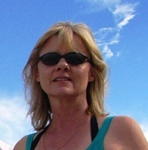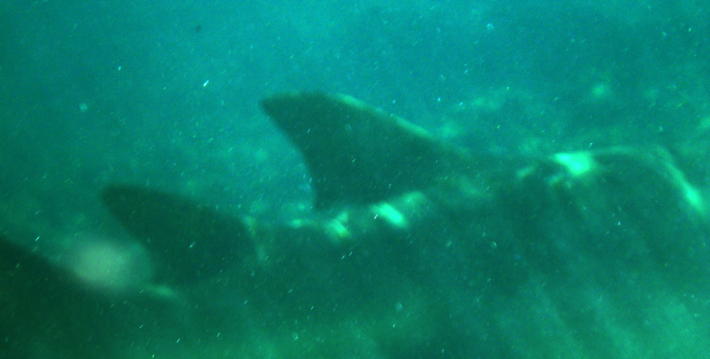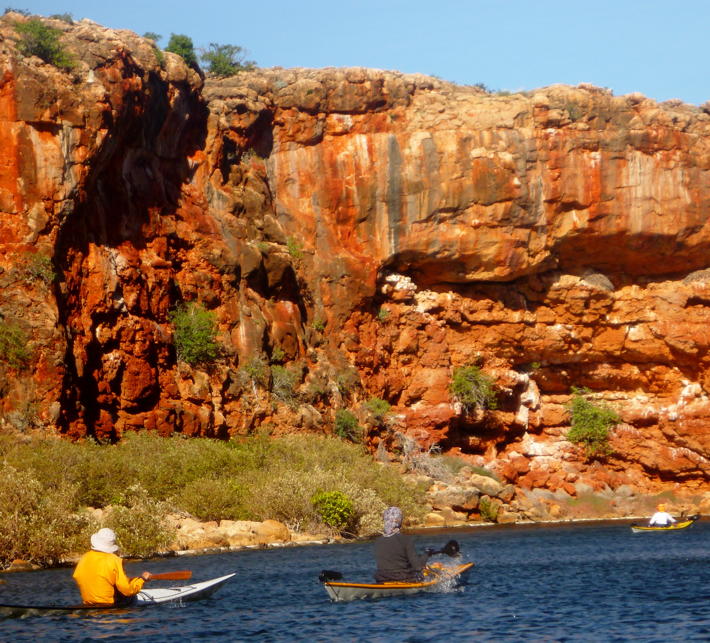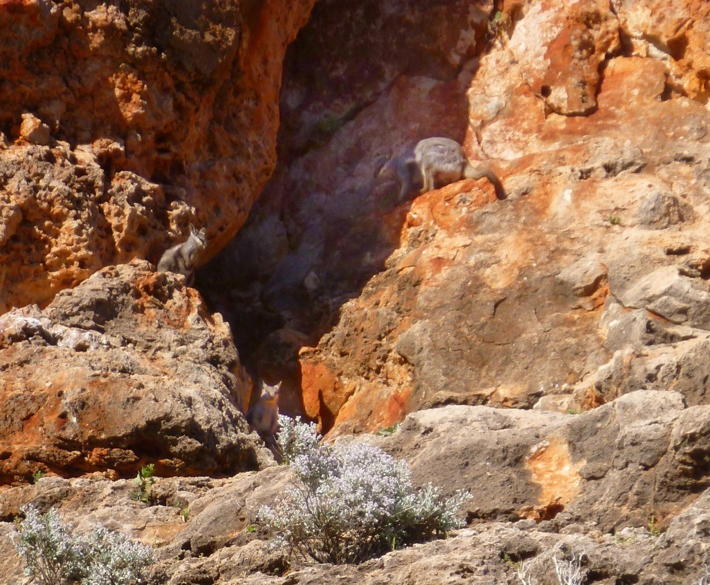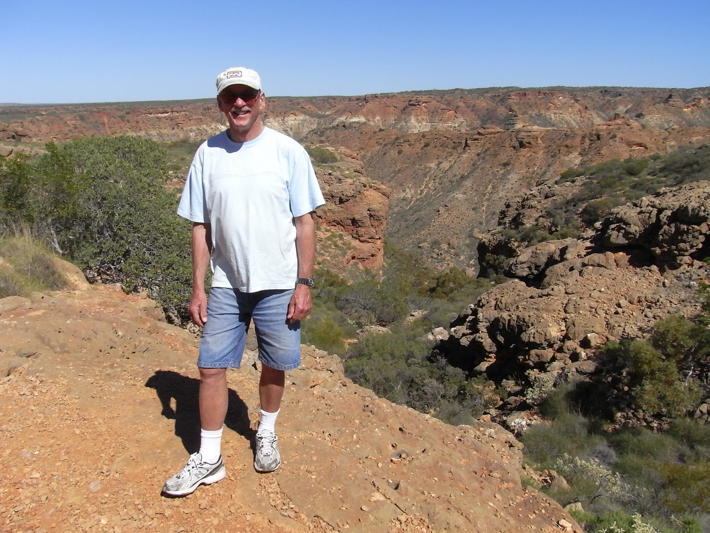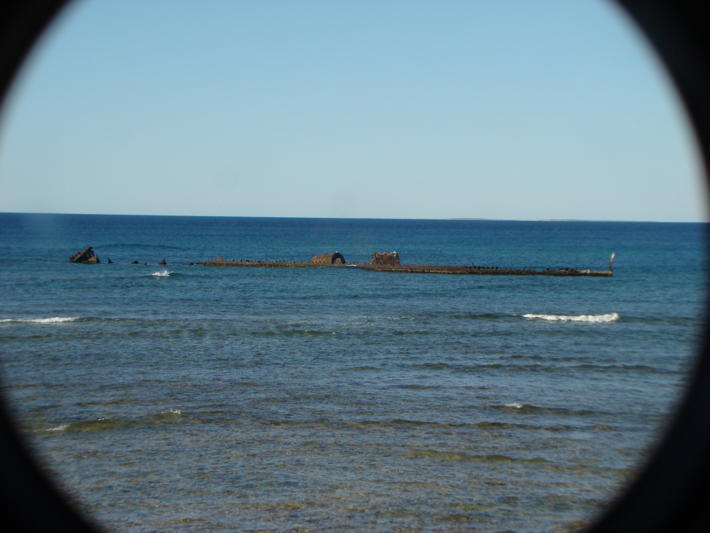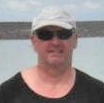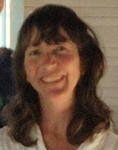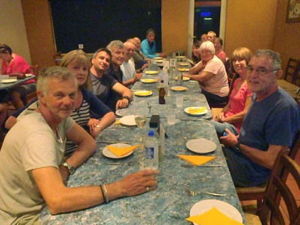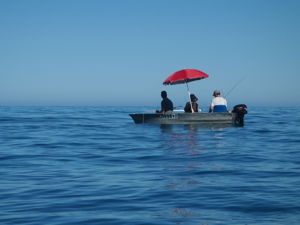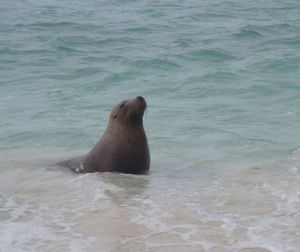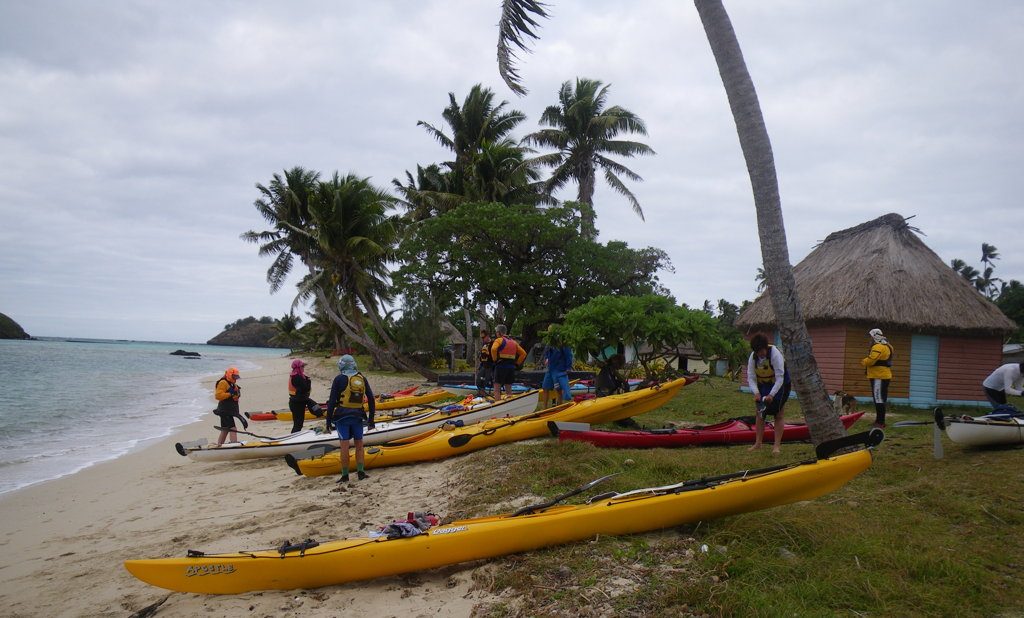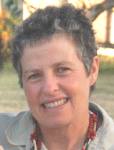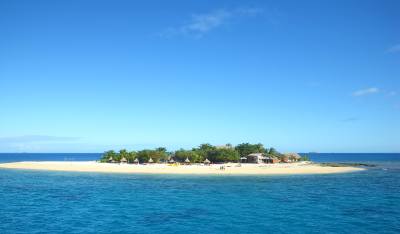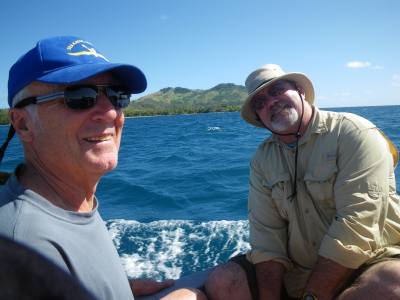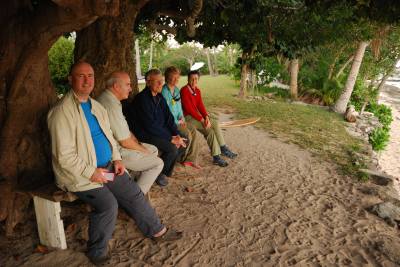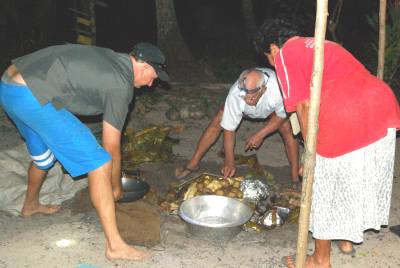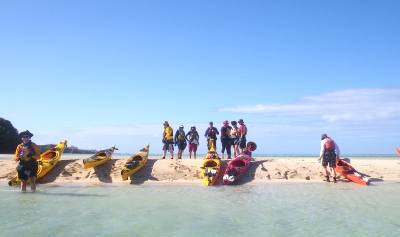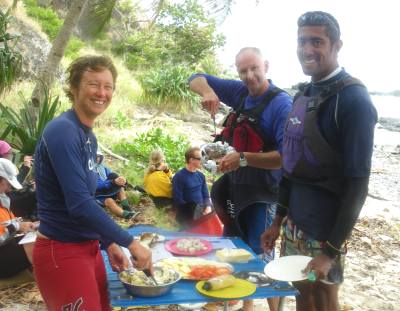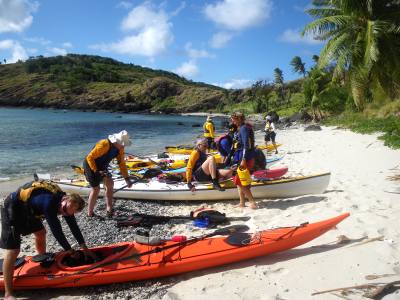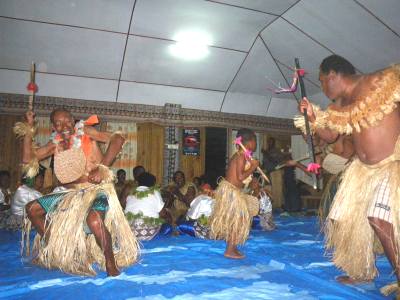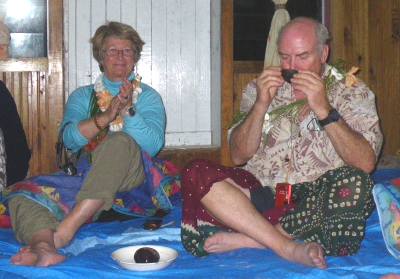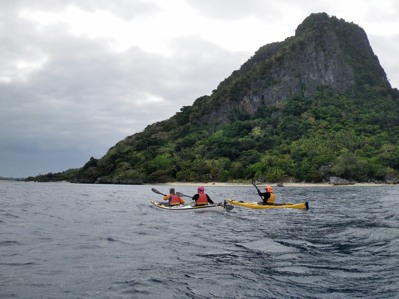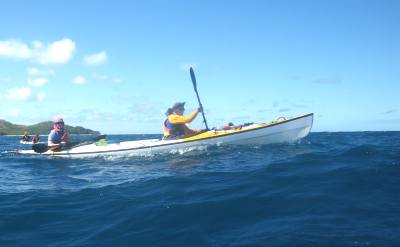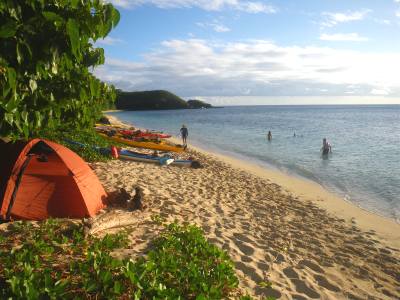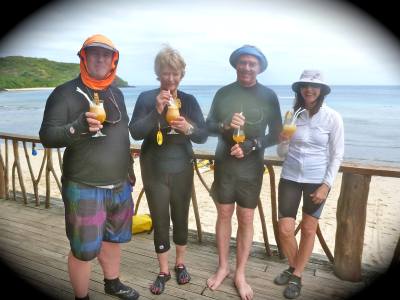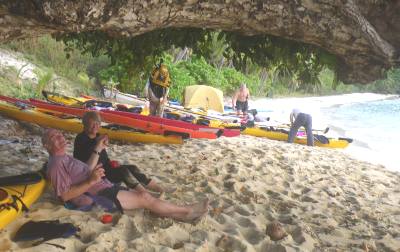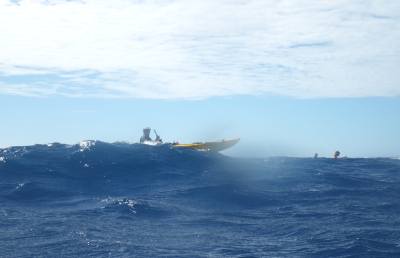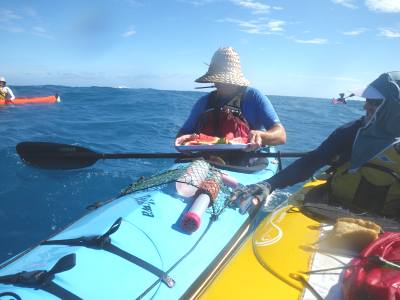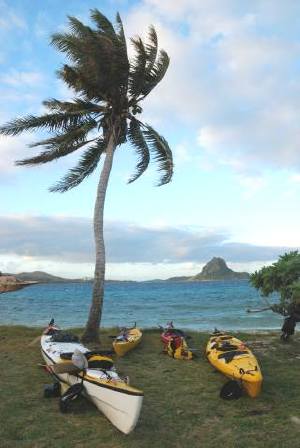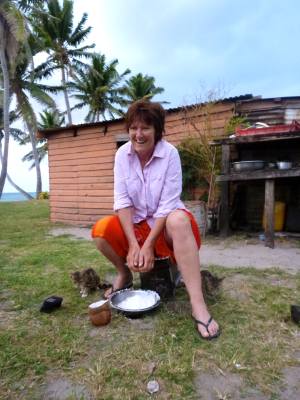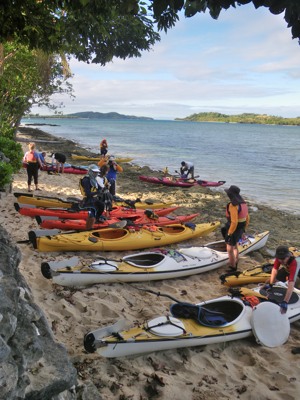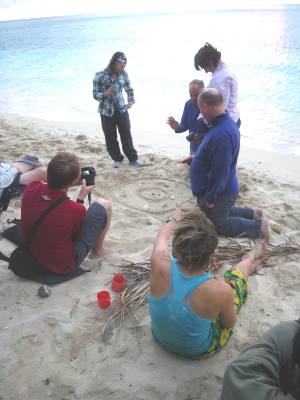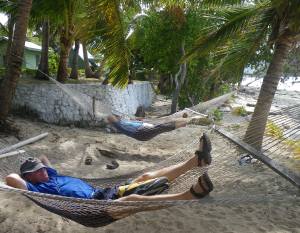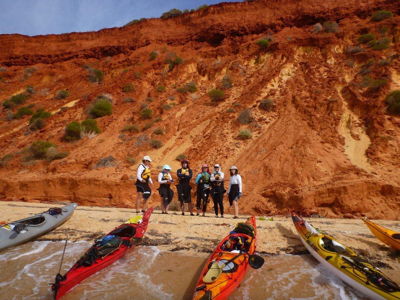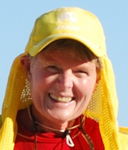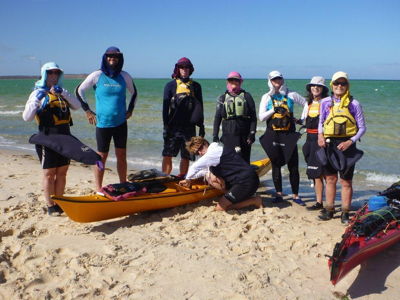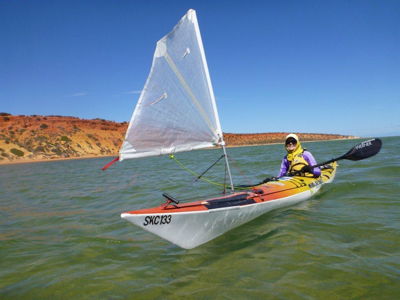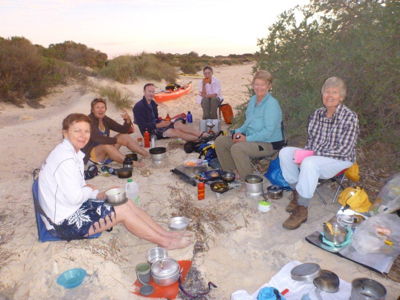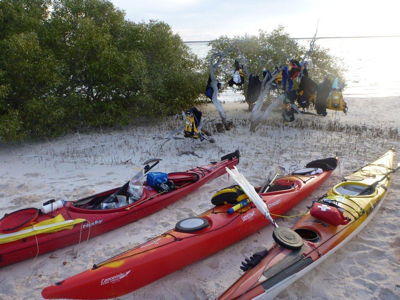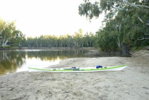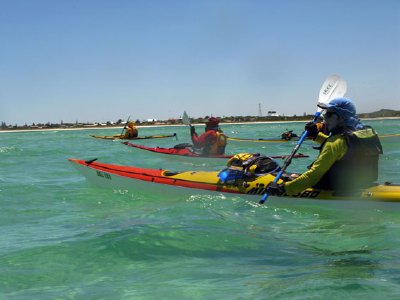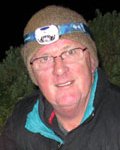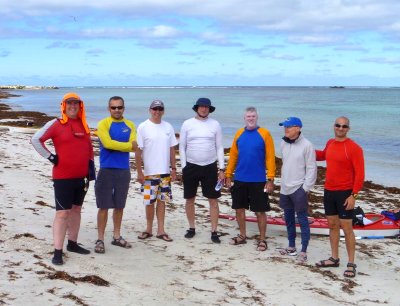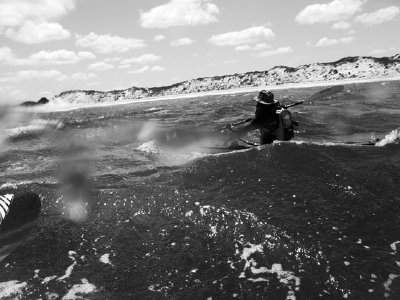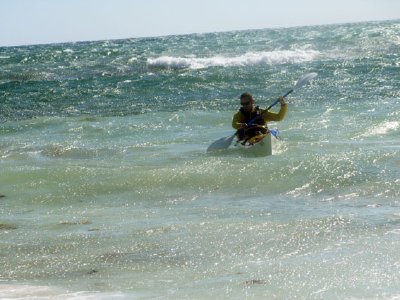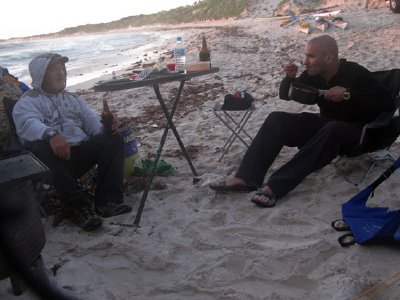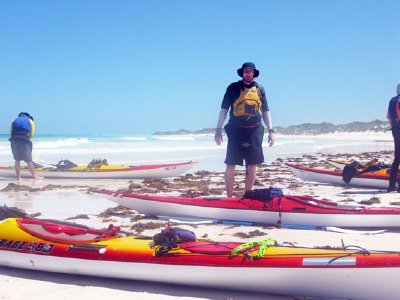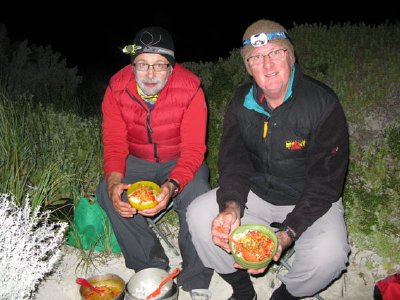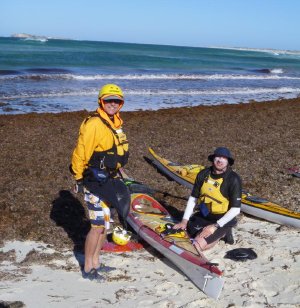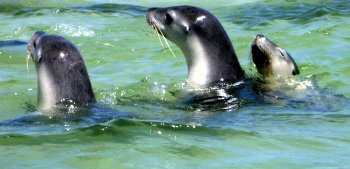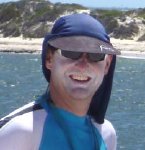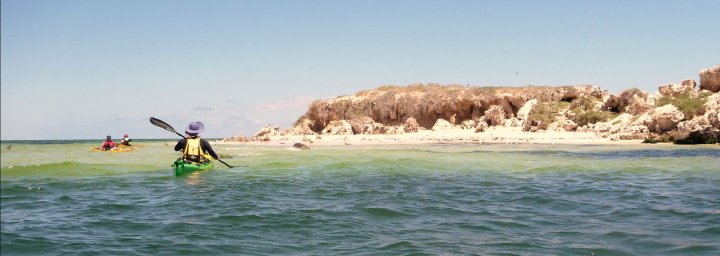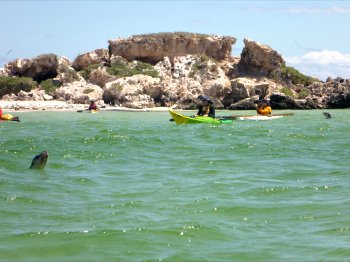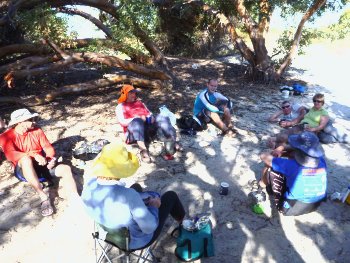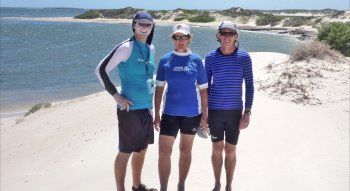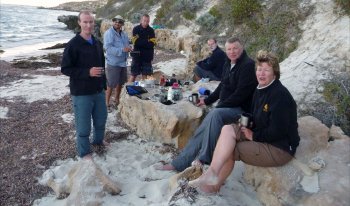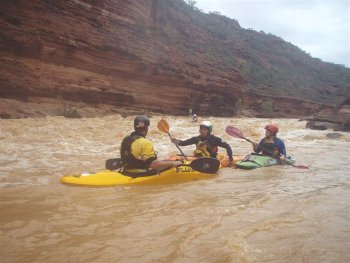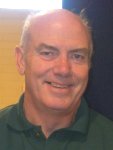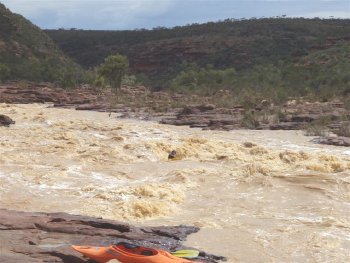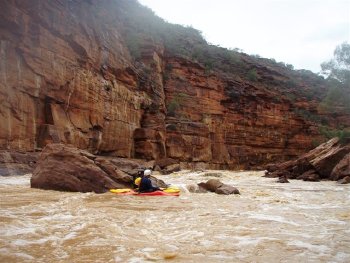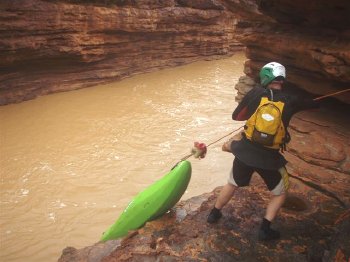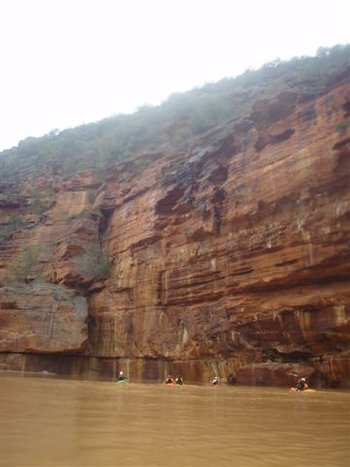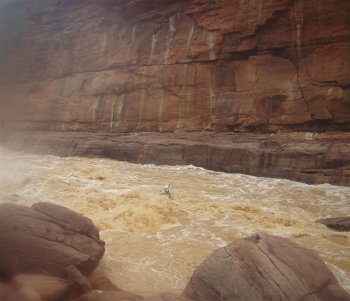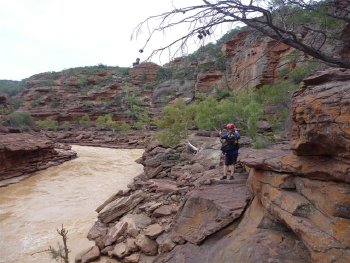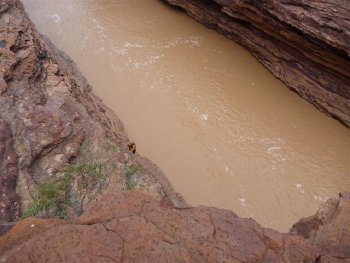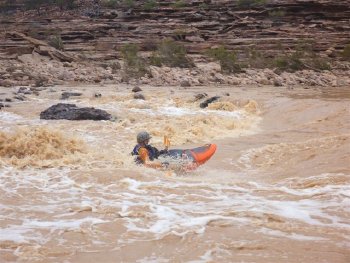By
Adrian Gawned
Raja Ampat, an archipelago of some 1500 islands, in the West Papua province of Indonesia. A marine ecology long renowned to divers the world over, but how to Kayak this area?
Research showed it could be done as Alex Vogel (WalkaboutAlex) and Halim (Deceased) of Sumatra Savages, had blogs on the internet. This led me to kayaks4conservation, a not for profit organisation, run in conjunction with Raja Ampat Research Conservation Centre (RARCC) and Conservation International. RARCC aims to end shark finning and explosive fishing by the locals by helping them set up homestay and tourism related businesses. 8 Kaskazi sea kayaks built locally are used. http://kayak4conservation.com
Deciding to circumnavigate Pulau Gam, and arming myself with all the information about tides, currents and winds I left Perth for Jakarta on the 21 October then onto Sorong when I purchased food supplies from the 2 supermarkets. With no availability of methylated spirit or gas canisters, my tea light candle stove trialled in Albany was required for making tea & coffee. A multi fuel stove using unleaded petrol is the other option.
Oct 24 I ferried to Waisai, transferred to RARCC on Pulau Kri where I met Tertius the manager of the initiative and liaison between the park and scientists who do research in the area. Collecting boat, equipment and necessary safety items including a spot tracker I was nearly ready to go.
After dinner with Tertius and a group of marine scientists, my first test, 2 nights in the Water Cottage (a basic hut built of pandana’s leaf and mangrove pole with no toilet facilities or fresh water) on the little island of Pulau Koh, 1.3kms away. Imagine a flat calm sea illuminated by the phosphorescence of numerous marine creatures giving the appearance it was lit by fairy lights, a taste of what was to come.

“Before Dawn” Water Cottage Pulau Koh.
Securing my kayak on the sliver of beach not covered by the tide, I slung my Hennessy Hammock, bought before I left, to ensure I was well away from scorpions, venomous spiders and adders and other nasty critters.
Lying comfortably in the diagonal, I was almost flat in my hammock; I fell asleep to the sound of the lapping water and marine life. Peace and tranquillity at last!!!! A cacophony of birds at dawn ensuring I did not miss sunrise. Paradise.
I took the time to sort what gear I needed for the 10 days (unsupported) paddling, I paddled my spare clothes and large backpack to RARCC for safekeeping and then down the coast of Kri to familiarise myself with the kayak.
The next day I crossed to Kri, collected supplied drinking water and a guide (Haja) to assist me with my journey, particularly language.
We crossed Selat Dampier and entered the maze like blue mangroves of Gam, a stretch of water consisting of inlets and channels with brilliant corals and fish life, the clarity of the water meant I could enjoy all this from the kayak. Exiting into the open sea we made our way to the first homestay at Yendebabo.

“Yendebabo” Homestay Pulau Gam
The homestays are very basic. They supply a mattress, pillow and mosquito net, a bucket bath and squat toilet, some have 12 volt solar systems, others generators for a few hours in the evening, a thermos of boiling water is provided with tea or coffee.
The following day we headed to the islands of Friwinbonda and Friwin, the crystal clear waters providing great viewing of the corals and aquatic life under the kayak. We pulled up onto a beach at Friwin, where Haja disappeared returning a short time later with 10 lengths of thin bamboo, which he stripped of foliage, soaked in the sea then tied them to the deck of his kayak.
A group of inquisitive children came by in a traditional dugout, one paddling, the rest bailing. My kayak was more watertight than their dugout.
We pushed on to “Five Rocks” where there is a small concrete plinth and plaque honouring the Japanese from the 2nd world war; paddling with a pod of dolphin until lunch, which was eaten on a beach on the island of Ura before heading to the homestay ‘Yenbesir Paradise’ hidden between numerous limestone karst islets.

“Fishing Village” Pulau Gam
The homestays on the East and north coasts are pole houses built over the water, backed by jungle or mangroves and to my surprise ‘Yenbesir’ provided a crisp white sheet, pillowcase and a towel that smelt “lemon fresh” straight from the laundry.
Watching my hosts’ children fishing and Haja build a bow and arrows from his collected bamboo filled in the afternoon. The bow and arrow were for hunting wild pig on his home island of Mansoear.
Dinner was freshly caught snapper, with rice and noodles. For dessert a packet of coffee crème biscuits with the thermos of boiling water. It was off to bed to the sound of fish jumping, birds, night insects and the call of a buffalo in the jungle.
Monday the 27th of October, the sun lit up this magnificent bay, the birds were active particularly the local butcher birds that called constantly as did a resident heron.
Breakfast and then onto Teluk Kaboi near the “Passage” the narrow channel between the islands of Gam and Waigeo, renowned for its drift diving, on the surface depending upon the tides it can be a millpond or a white-water course.
After repairing a broken rudder cable we continued across Kaboi Bay to our destination, the water changing from brilliant turquoise and blue to dark green. Approaching the “Passage” and Teluk Kaboi we paddled amongst the islets to the homestay at Teluk Kaboi. The potential for this homestay is amazing with it being tucked into the side of a cliff, built over water with a permanent water supply from a cave above. Unfortunately it was also the most basic and not for the faint hearted. A Pinisi live-aboard Dive boat was anchored in the bay.

“Pinisi” The Passage.
Tuesday we headed for the entrance to ‘The Passage’, it was almost slack tide and as it was a neap cycle the currents were not as strong. Rounding the point we drifted into ‘The Passage’, less than 20 metres at its narrowest.
Negotiating several narrow turns we broke out into the wider channel where the current was non-existent. We set to crossing Warparim Bay for the “Hidden Bays of Pef”. Midway the rain started, the wind picked up creating a wind wave, we pressed on. The first clap of thunder was far off, there was no lightning, within minutes the storm was overhead, thunder crashed and the first of many lightning bolts hit the water, we needed to get off the water, our options were limited. Run for the mangroves 3.5 km away or to a permanently moored fishing vessel about 2km distant. We chose the fishing boat.
We clambered up the sides of the outriggers and negotiated planks and stays to reach the main hull, where we were offered food and tea by the crew. A local in an outboard powered outrigger canoe arrived seeking sanctuary.

“Tropical Rain” The Passage.
The storm passed, we paddled on to the hidden bays, a myriad of inlets, fingers and channels, where we passed a group of divers and a partially completed homestay, my guide would not venture at all into the bays to our left stating there were crocodiles; we drifted on the currents taking in our surroundings.
From the hidden bays we continued toward the island of Pef, where we planned to camp. Reporting to the Police at the Indo Pearls pearl farm (an Australian venture staffed by Japanese) and registering the duration of our stay in the area as required.

“Sunset” Pulau Gam.
We continued to Pef where Haja advised a ‘saltie’ had been seen in the area we would camp, instead we would camp at the rear of the Raja for Divers resort. Paddling into the black water lagoon at the rear of the resort surrounded by mangroves, it looked a perfect habitat for crocs. I discovered people dived here to see pygmy sea dragon and nudibranch.
Discovering Haja had friends working at the resort, I wondered if the croc story was true!
Wednesday the 29th I was awoken with roosters crowing and the generator at 0500hrs. We paddled to Airborek arriving around lunchtime, washed away the salt, clothing was hung out to dry and boats opened up to let air and sun into them to dry them out, they had taken water the previous day.
The afternoon was spent snorkelling on the nearby reef with barracuda, black tip shark, turtles, rays and numerous other species. A walk around this little islet took about 30 minutes. As the sun set it was a good opportunity for photographs. The staple diet of the islands, rice and fish, for dinner.

“Mushroom Coral” Pulau Airboraik.
Pulau Airborek, like many small islands in the Pacific is barely a metre above sea level and there is evidence of increased erosion, with global warming rising sea levels will see it inundated in the future, houses are already built on stumps about a metre high for the not too infrequent high tides that occur and flood the immediate coastal area.
Thursday began with the birds and barking dogs, a late start was planned to avoid the outgoing tide, with a short paddle to the homestay near Sawingrai village on Gam. A broken rudder cable along the way made the paddle that much harder.
My cottage was a few feet from the water’s edge and provided great views of the sunset. It was one of the few facilities with a tiled floor, but the generator in the toilet was somewhat off-putting. The bucket bath was always a welcome event at the end of the day; however water conservation was an issue as the women had to obtain water from a well some distance away.
After another magnificent sunset I went to bed to the sound of the generator, coconuts falling from the trees and other unidentified night sounds.
Up at first light I watched as the open wood fire was lit in the lean-to kitchen. Breakfast a plate of hot fish cutlets cooked in a chilli sauce and 6 small bright green pancakes filled with fresh coconut and sugar started the day.
A short 3 – 4 hour paddle to Besir Bay, the rumour of a ‘saltie’ near the mouth meant we scanned the shoreline and our surroundings closely, every piece of timber on the surface given added attention.

“Besir Bay” Pulau Gam.
We headed for a limestone tunnel that at low tide allowed you to enter another lagoon, and wandered among the islands and fingers, investigated a cave inhabited by fruit bats and continued to the tunnel carved through the limestone karst, with the tide out we paddled through and into the lagoon, the water however was murky and surrounded by mangroves it was not inviting.
Exiting the tunnel we continued further before a stop was made at a limestone outcrop in the middle of the bay, where we climbed a rustic wooden ladder up the side of the formation to higher ground to get a magnificent view of the bay and its islets.
Back onshore it was time for lunch, we then walked to Sawingrai village to find a guide to take us into the mountains in search of Wallace’s Red Bird of Paradise (named after the naturalist Alfred Russel Wallace). We entered the jungle and then waited, the guide pointed into the tree canopy above, there were about four of these magnificent birds. We sat and watched as they preened, sang and flew through the canopy. A photo cannot do them justice.

“Besir Bay” Pulau Gam.
Saturday 1st November the day started at sunrise, up and about and packed in preparation for the last leg to Pulau Kri. Having had a breakfast of cassava chips dipped in batter then deep fried with a cup of sweet black tea, we headed up the coast of Gam toward Kormansiwin village, the tide was still running out rapidly, my guide suggested crossing the Dampier Strait immediately but I chose to paddle along the coast instead until the tide was spent, then cross.
We stopped on a beach for a brief stretch and drink then resumed our paddle up the coast until the current had eased then turned east to make the crossing to Pulau Mansoear and the village of Yenbuba 7kms distant.
Arriving at Yenbuba we pulled up on the beach, got out the lunchboxes as the rain and thunder started yet again, we ate in silence watching the rainstorms roll up the Dampier Strait over Pulau Mansoear and continue to Gam and Waigeo in the distance.

“Rainstorm” Pulau Mansoear.
Lunch over we crossed the channel between Mansoear and Kri, and then followed the shoreline of Kri to Sorido Bay Resort and RARCC where the paddle would end.
Accommodation for the last night was luxurious, an air-conditioned room, with a hot shower, a real toilet and a comfortable bed. Lunch at Sorido Bay comprised a huge variety of dishes, salads, eggs and chicken the first I had seen in over 10 days and was taken with divers from all around the globe enjoying the underwater delights of the area. I was known as Kayakman and introduced as such.
After lunch I packed gear and then sat in the waterside gazebo watching a school of black-tip reef sharks patrolling along the beach. I dined with the other guests and had just a single celebratory Bintang beer which was enough to send me off to bed.
My final day in the “Four Kings” I opted for the late transfer to get a last snorkel on the house reef, it was memorable, brilliant red starfish, angel fish, clown fish, huge bump-head parrot fish, black-tip reef sharks and turtle the list went on. It was a fitting end to what had been a magnificent 10 days around Pulau Gam.

“Red Starfish” Sorido House Reef.
The boat to Sorong arrived at midday and I headed off on the homeward leg of my adventure vowing to return to see and do more of the area before it is destroyed by mass tourism and consumerism. (Haja my guide spent the days collecting floating debris in an effort to preserve the environment).
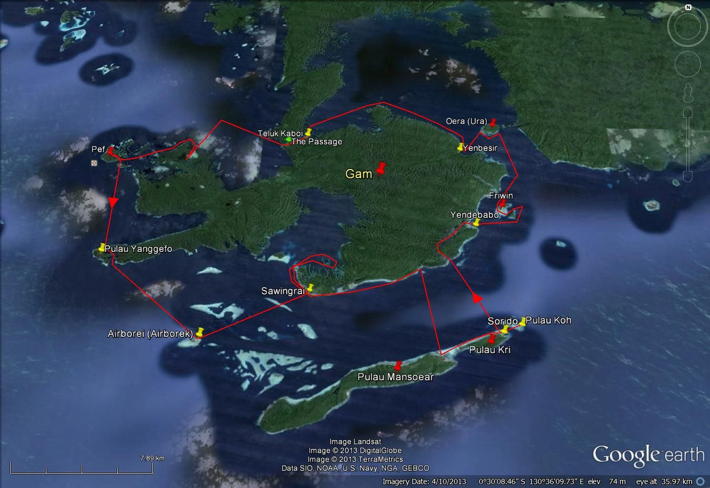
Thanks go to Halim (aka Georg Jackstadt) from Sumatra Savages for setting me on this path, sadly I couldn’t tell him I did it, he passed away from Black fever* in March. Alexander Vogel (Walkabout Alex) who has done the area twice by kayak and intends to go back, his knowledge and advice was invaluable and lastly Tertius Kammeyer for all his help and assistance. Planning for stage two has already begun.
Anyone who considers travel to this area without the necessary prophylaxis for Malaria and injections for Japanese Encephalitis, Typhoid and Hepatitis A should reconsider their plans, expensive as they are, it is worth remembering these diseases can kill or maim you.
Distance: 180kms
Kayak hire USD $520.00 for 10 days.
Boat Transfers USD $185.00.
Sorido Bay Accommodation USD $180.00.
Guide USD $240.00 for 8 days.
Homestays USD $280.00 (7 nights) inclusive of 3 meals per day.
Airfares, Accommodation and Sundries. USD $1800.
About the author:
Adrian lives in Albany where he runs his own business, he has been paddling on and off over the years and joined the Sea Kayak Club in 2011. Previous expeditions have included the Gulf of Thailand and Koh Chang Islands Group. He prefers to paddle solo for the solitude or with 2 to 3 other paddlers.
© Adrian Gawned 2013


